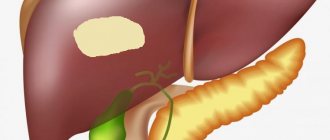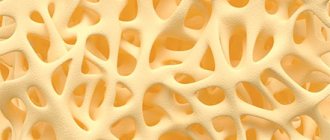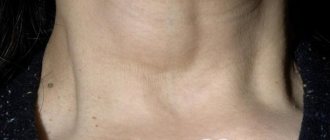Non-alcoholic fatty liver disease (abbreviated as NAFLD or NAFLD) is a disease characterized by the deposition of fat in the liver cells, their subsequent inflammation and destruction. This is one of the most common chronic pathologies of the biliary system, which occurs against the background of metabolic disorders, and if left untreated, is complicated by cirrhosis and functional liver failure. The dangerous consequences of the disease can be prevented only with timely diagnosis and competent comprehensive treatment.
What is the disease? Brief description and etiology
NAFLD, non-alcoholic fatty liver disease, is a very common pathology that is characterized by the accumulation of lipids in liver cells (hepatocytes). Since drops of fat are deposited inside cells and in the intercellular space, disturbances in the functioning of the organ are observed. If left untreated, the disease leads to dangerous complications, increasing the risk of developing cardiovascular diseases, cirrhosis, or the formation of a malignant tumor in the liver.
Non-alcoholic fatty liver disease is a modern problem. According to research, the prevalence of the disease is about 25% (in some countries up to 50%). True, it is difficult to call statistics accurate, because it is rarely possible to diagnose the disease on time. By the way, both men and women, and even children, are prone to it. Most people suffer from the disease in developed countries, which is associated with an office, sedentary lifestyle, constant stress and poor diet.
What does liver in fat mean?
As a result of the development of the pathological condition, the liver becomes overgrown with fat, and small-droplet or large-droplet accumulation of lipid deposits is observed in certain areas of the liver parenchyma.
In advanced cases, fat accumulation can reach a large size, which leads to complete filling of the liver parenchymal tissue with lipids.
When examining liver tissue affected by a pathological process under a microscope, the doctor observes a large number of hepatocytes containing large fatty droplets or a large number of small lipid accumulations.
The accumulation of lipids leads to the fact that the liver becomes unable to fully perform its physiological functions.
Steatosis becomes a serious disorder when it provokes the occurrence of hepatomegaly and one of the forms of hepatitis - steatohepatitis. At this stage of progression, fatty liver disease provokes its increase and the development of inflammatory processes.
In the process of fat accumulation, a pathological process develops, consisting in the degeneration of liver tissue. As a result of this degeneration, specialized cells of the liver parenchyma - hepatocytes - are replaced by fat cells.
The development of fatty hepatosis in the absence of timely adequate therapy can lead to irreversible cirrhotic changes. In particularly advanced cases, pathology can provoke the appearance of liver failure and subsequent death.
The progression of steatosis increases the likelihood of liver cirrhosis, cardiovascular disorders, endocrine and metabolic pathologies. In addition, the presence of fatty liver can provoke the occurrence of allergic reactions, varicose veins and some others.
In order to avoid the negative consequences of the development of pathology in the body, you should know the causes of its occurrence and methods of treating the disease.
The main reasons for the development of fatty disease
The question of why and how non-alcoholic fatty liver disease develops is still being studied at many research centers. But over the past few years, scientists have been able to identify several risk factors:
- Overweight (most patients with this diagnosis are obese).
- On the other hand, fatty hepatosis can also develop against the background of sudden weight loss, because such a phenomenon is accompanied by a change in the level of fats and fatty acids in the body.
- Risk factors include diabetes mellitus, especially type 2.
- The risk of developing the disease is increased in people with chronic hypertension.
- NAFLD can appear due to increased levels of triglycerides and cholesterol in the blood.
- Taking certain medications is potentially dangerous, in particular antibiotics and hormonal drugs (birth control pills, glucocorticosteroids).
- Risk factors include poor nutrition, especially if the diet contains foods rich in easily digestible carbohydrates and animal fats.
- The disease develops against the background of diseases of the digestive tract, including dysbiosis, ulcerative lesions, pancreatitis, and impaired absorption of nutrients by the intestinal walls.
- Other risk factors include gout, pulmonary diseases, psoriasis, lipodystrophy, cancer, heart problems, porphyria, severe inflammation, the accumulation of large amounts of free radicals, and connective tissue pathologies.
Causes
NAFLD (otherwise known as liver steatosis, steatohepatosis) is accompanied by symptoms characteristic of alcoholic hepatosis, and the cause of organ damage is not alcohol abuse.
The mechanism of development of the disease is not fully understood, but doctors have come to the conclusion that some of the leading provoking factors are:
- insulin resistance (decreased or completely absent sensitivity to the effects of insulin);
- diabetes mellitus type II;
- obesity;
- metabolic syndrome (obesity in combination with arterial hypertension or diabetes mellitus, high cholesterol and dyslipidemia - a disorder of lipid metabolism).
Insulin takes part in carbohydrate and fat metabolism. Insulin resistance increases the level of insulin in the blood, which leads to metabolic disorders. The consequence is the development of type II diabetes mellitus, cardiovascular pathologies, and metabolic syndrome.
With fatty hepatosis, due to metabolic disorders, the liver not only accumulates incoming fats, but also begins to intensively synthesize them.
According to statistics, non-alcoholic fatty hepatosis is more often diagnosed in women over 40-50 years old, less common in men and children
In addition to the listed factors, the development of non-alcoholic hepatosis can be provoked by:
- previous operations aimed at reducing body weight (gastric anastomosis or gastroplasty);
- long-term use of certain medications (Methotrexate, Tamoxifen, Amiodarone, nucleoside analogues and other hepatotoxic medications);
- constant malnutrition, sudden weight loss;
- Wilson-Konovalov disease (congenital disorder of copper metabolism, leading to severe diseases of the central nervous system and internal organs);
- damage by toxins (petroleum products, phosphorus).
Non-alcoholic fatty liver disease: classification and stages of development
There are several ways to classify a disease. But more often doctors pay attention to the location of the process. Depending on the location of the accumulation of lipid droplets, focal disseminated, severe disseminated, diffuse and zonal forms of hepatosis are distinguished.
Non-alcoholic fatty liver disease develops in four stages:
- Fatty liver, in which there is an accumulation of a large number of lipid droplets in hepatocytes and the intercellular space. It is worth saying that in many patients this phenomenon does not lead to serious damage to the liver, but in the presence of negative factors, the disease can move to the next stage of development.
- Non-alcoholic steatohepatitis, in which the accumulation of fat is accompanied by the appearance of an inflammatory process.
- Fibrosis is the result of a long-term inflammatory process. Functional liver cells are gradually replaced by connective tissue elements. Scars form, affecting the functioning of the organ.
- Cirrhosis is the final stage of fibrosis, in which most of the normal liver tissue is replaced by scars. The structure and function of the organ are disrupted, which often leads to liver failure.
General characteristics of fatty hepatosis
The disease steatosis occurs when there is excessive accumulation of fat in the liver parenchyma.
In the first stages, lipids are deposited in hepatocytes (as the cells actively synthesize the fats our body needs). Further, when they are destroyed from excessive stress and circulatory disorders, fat can already be found outside the hepatocytes.
This failure is called fatty degeneration or fatty degeneration of the liver, treatment should be immediate. This leads to disruption of all functions of the organ: synthesis of proteins, fats, carbohydrates, deposition of vitamins and microelements, bile formation, neutralization of toxic substances.
What symptoms are accompanied by the disease?
Many people are diagnosed with non-alcoholic liver hepatosis. Symptoms and treatment are the questions that interest patients most. As already mentioned, the clinical picture of the disease is blurred. Often, obesity of liver tissue is not accompanied by pronounced disorders, which significantly complicates timely diagnosis, because patients simply do not seek help.
What are the symptoms associated with non-alcoholic fatty liver disease? The symptoms of the disease are as follows:
- Due to disturbances in the liver, patients often complain of digestive disorders, in particular, nausea, heaviness in the abdomen that occurs after eating, and problems with stool.
- Signs include increased fatigue, periodic headaches, and severe weakness.
- At later stages of development, an increase in the size of the liver and spleen is observed. Patients complain of heaviness and pain in the right hypochondrium.
- In approximately 40% of patients, hyperpigmentation of the skin on the neck and armpits can be observed.
- Spider veins (a network of dilated capillaries) may appear on the palms.
- The inflammatory process is often accompanied by jaundice of the skin and sclera of the eyes.
Symptoms and stages
The liver is important for removing toxins from the body. If it does not work properly, various symptoms may occur.
If the body produces too much fat or if fat is poorly metabolized, it can accumulate in the liver.
If too much fat grows in the liver, it can cause fatty liver. If fat continues to accumulate, it can lead, in some cases, to NASH and ultimately to cirrhosis and liver failure.
Fatty liver
At a threshold level, more than 5-10% of the liver's weight is fat.
If more fat than this occurs in the liver, it is known as NAFLD, or simple fatty liver. It's not healthy, but it's not necessarily severe enough to cause any problems, and the person usually doesn't notice any symptoms.
Most people with simple fatty liver do not know they have it. They may only find out after testing for some other condition or because other risk factors indicate a test is a good idea.
About 30 to 40 percent of adults in the United States have NAFLD. However, it is difficult to establish an exact figure as there is no single set of criteria to define NAFLD.
For most people, the condition does not progress beyond this stage.
Non-alcoholic steatosis
If the fat continues to grow and the liver becomes inflamed, NASH results. In the US, it affects between 3 and 12 percent of adults.
About 75 percent of patients will have a liver tumor or hepatomegaly.
Symptoms may include:
- tiredness and tiredness, including muscle weakness and lack of energy
- discomfort and possible swelling in the upper abdomen
- weight loss
- low appetite
- nausea
Symptoms may be vague and may be similar to a number of other problems. Tests may be performed to correct other conditions.
Scientists are not sure why some people are more likely to develop NASH.
Cirrhosis and liver failure
Over time, 10-25% of people with NASH will develop scarring or fibrosis, also known as cirrhosis and liver failure.
Symptoms include:
- fatigue and weakness
- nausea, vomiting and diarrhea
- tarry stool
- swelling and pain in the abdomen
- yellowing of the skin and eyes, known as jaundice
- confusion, difficulty focusing, memory loss and hallucinations
- itchy skin
- bleeding and bruising easily
In severe cases, a liver transplant may be required.
Fat disease in children
Unfortunately, non-alcoholic fatty liver disease is often diagnosed in children and adolescents. Moreover, the number of such cases has increased significantly over the past few days, which is associated with rising obesity rates among minor patients.
Correct diagnosis is important here. It is for this purpose that during routine school medical examinations, doctors measure the child’s body parameters, measure blood pressure, and check the level of triglycerides and lipoproteins. These procedures make it possible to diagnose the disease in a timely manner. Non-alcoholic fatty liver disease in children may not require any specific treatment (especially if it is detected early). Correcting the diet and proper physical activity help normalize liver function.
Treatment and management
There is no cure for fatty liver, but lifestyle choices such as achieving or maintaining a healthy weight can reduce the risk and possibly reverse damage in the early stages.
Diet tips
To reduce the risk of NAFLD, it is best to:
- Eat a balanced diet with moderate portions
- eat a lot of fruits and vegetables
- Consume both proteins and carbohydrates, but limit fats and sugars
- reduce salt intake
- replace saturated and trans fats with monounsaturated and polyunsaturated fats
The National Institute of Diabetes and Digestive and Kidney Diseases (NIDDK) recommends the following dietary tips:
- Replace trans fats and animal fats with olive oil, flaxseed oil, corn oil, soybean oil, and safflower oil.
- eat fatty fish instead of meat
- avoid foods high in simple sugars such as fructose, found in sweetened drinks, sports drinks and juices
- eat more low glycemic index (GI) foods such as fruits, vegetables and whole grains
- eat less high-GI foods such as white bread and white rice
- avoid drinking alcohol or drinks in moderation
Scientists are looking at whether vitamin E can help, but more research is needed. Those considering taking supplements or herbal remedies should always consult a doctor first.
A healthy diet and regular exercise reduce the risk of a wide range of conditions, including diabetes and cardiovascular disease.
Diagnostic measures: laboratory tests
If this pathology is suspected, laboratory tests are performed on patient blood samples. When studying the test results, you should pay attention to the following indicators:
- Patients experience increased activity of liver enzymes. The increase is moderate, approximately 3–5 times.
- There is a disturbance in the metabolism of carbohydrates - patients suffer from impaired glucose tolerance, which in terms of symptoms corresponds to type 2 diabetes.
- Another sign is dyslipidemia, which is characterized by increased levels of cholesterol and triglycerides in the blood.
- Disturbances in protein metabolism and increased bilirubin levels are observed only in advanced cases.
Signs of liver disease
Most often, there are no symptoms of fatty liver disease, so you may be living with the disorder and not realize it. Over time, which can sometimes take years or even decades, some signs may begin to surface. Symptoms of this problem include:
- fatigue
- apathy
- weight loss
- loss of appetite
- weakness
- nausea
- confusion
- problems concentrating
- pain in the central or right upper abdomen
- enlarged liver
- bloating and gas
- dark urine
- excessive bruising
- excessive sweating
- constipation
- dry and dark patches on the neck and armpits
Sometimes, fatty liver results in cirrhosis of the liver, a disease that occurs when the liver weighs about 1.5 kg. and is the largest solid organ in the body. This is the most life-threatening type of fatty liver. Over time, healthy liver tissue is replaced by scar tissue, which prevents the liver from functioning normally. Scar tissue blocks blood flow through the liver and slows down the liver's processing of nutrients, hormones, medications, and naturally produced toxins, as well as its production of proteins and other substances. Symptoms of cirrhosis include fluid accumulation in the body, muscle weakness, internal bleeding, yellowing of the skin and eyes, and liver failure.
As a rule, fatty liver does not make itself felt until checked by a doctor. There are medical tests and devices that are used to detect the formation of BAOP. The doctor may notice that the patient's liver is larger than normal. The disease can also be detected through a blood test; the presence of a large number of certain enzymes will indicate that you have it. An ultrasound is used to take a detailed look at your liver, and a biopsy will be enough to diagnose BAOP. Your doctor will remove a small piece of liver with a needle and check it for inflammation, signs of fat, or damaged liver cells.
If you think you are at risk for BAOP or have noticed some of these symptoms, contact your doctor for testing.
Causes and risk factors for liver disease
Fatty liver occurs when the liver has problems breaking down fat, causing fat to accumulate in the liver tissue. Causes of this disease include:
- Medications
- Viral hepatitis
- Autoimmune or inherited liver disease
- Fast weight loss
- Malnutrition
There are a number of risk factors that increase your chances of having BAOP; these include:
- Obesity
- Gastric bypass
- High cholesterol
- High triglyceride levels in the blood
- Type 2 diabetes
- Metabolic syndrome
- Sleep apnea attacks
- Polycystic ovary syndrome
- Hypoplasia of the thyroid gland (hypothyroidism)
- Hypofunction of the pituitary gland (hypopituitarism)
Obesity is associated with an increased risk of developing BAOP, according to a study conducted at Washington University School of Medicine in St. Louis. The main feature of BAOP, called steatosis, occurs when the rate of liver uptake of fatty acids from plasma and synthesis of fatty acids is greater than the rate of fatty acid oxidation and excretion. This metabolic imbalance is an important factor responsible for the formation of BAOP.
A review published in the Journal of Clinical Gastroenterology in 2006 states that BAOP is highly prevalent among patients undergoing bariatric surgery, ranging from 84% to 96%. The review also noted that the disease tends to be most common among men, and the risk of developing PAOP increases with increasing age and after menopause in women.
Foods that make fatty liver worse
Alcohol
If you have fatty liver and you drink, stopping drinking is the first thing you need to do. Alcohol is the culprit; It's what causes liver disease because your liver can't break it down fast enough as your body needs it to. Fatty liver disease is common in alcoholics not only due to poor diet, but also due to toxicity and inflammation, according to a review conducted at the Bronx Veterans Affairs Medical Center in New York City. Even if you only have non-alcoholic fatty liver disease, it is still best to eliminate alcohol from your diet.
High carbohydrate foods _ _
Foods such as bread, rice, cereals and corn should be avoided. White bread and carbohydrates should be eliminated or reduced, as well as some whole grain foods. When we consume too many refined carbohydrates, insulin levels are at their peak, and insulin sensitivity is a major factor in liver disease. Read the labels on all packages that contain whole grains, and do not buy products that say “fortified.” If you want some bread, buy fresh bread that is made at a bakery or health food store—you can also try bread made with gluten-free flour or various sandwich substitutes. If you're going to buy rice, choose brown rice.
Sweet drinks
Sports drinks, soda, energy drinks and juices are full of sugar and artificial sugar substitutes. It is the sugar that enters the body that causes fatty liver. On average 350 gr. soda, for example, contains 10 teaspoons of sugar! Your body is unable to break down the amount of sugar that most Americans consume every day, and this has a detrimental effect on your liver. Sugar, especially fructose, contributes to the development of BOP and its progression, according to a study conducted at Emory University School of Medicine in Atlanta. Significant associations were found between increased fructose intake and obesity, dyslipidemia, and insulin resistance.
Processed foods
Hydrogenated oils, refined sugar, and fast foods are known to be toxic to the body. Nitrates and nitrites, for example, are commonly found in processed and processed foods and have been implicated in serious illnesses, including cancer. High fructose corn syrup, which is found in processed foods, is the single biggest cause of fatty liver disease; you should stay away from these foods to cure your liver disease.
Foods that help fight disease
Raw vegetables
A review published in the European Journal of Medicinal Chemistry states that natural products found in vegetables, fruits, plant extracts and herbs have traditionally been used to treat liver diseases. Therefore, it is important to add vegetables to your daily diet.
The easiest way to do this is to drink vegetable juice. For liver dysfunction, vegetable juice has the added benefit of being easier to digest and absorb into the body. Vegetables ideal for liver detoxification include cabbage, zucchini, lettuce, cauliflower, broccoli, Brussels sprouts, asparagus, beets and celery; Try something like beet juice to start.
Ginger root
High-fiber foods help maintain a healthy gastrointestinal tract by speeding up the elimination of toxins from the body. For example, ginger root benefits the digestive system. Make ginger tea by boiling ginger slices in green tea or water. You can also add ginger to stir-fries, salads, or smoothies.
Sweet potato
Due to the potassium content in them, sweet potatoes are beneficial as they help cleanse the liver. One sweet potato contains about 700 milligrams of potassium! It is also rich in vitamins B6, C, D, magnesium and iron. Sweet potatoes are easy and enjoyable to eat because they are naturally sweet and the sugar is slowly released into the bloodstream through the liver, so it won't cause a spike in your blood sugar. There are tons of healthy and delicious sweet potato recipes you can try at home today.
Bananas
Banana contains 470 milligrams of potassium, also great for cleansing the liver and reversing low potassium levels; Plus, bananas help with digestion and remove toxins and heavy metals from the body.
Dandelion root
The vitamins and nutrients in dandelion help cleanse the liver and keep it functioning properly. Dandelions also help our digestive system maintain proper bile flow. These are natural diuretics and quickly rid the liver of toxins. Dandelion tea or its stems contains high levels of vitamin C, which helps in mineral absorption, reduces inflammation and prevents the development of disease.
Milk thistle
Milk thistle supports and helps the liver and is a powerful detoxifier. It helps restore liver cells by removing toxins from the body that are broken down by the liver. According to a study published in Digestive Diseases and Sciences, milk thistle has the ability to reduce mortality rates in patients with liver failure; it can naturally reverse the harmful effects of drinking alcohol, pesticides in our food, heavy metals in our water supply, inhaling polluted air, and even poison.
According to a 2010 study, milk thistle helps treat alcoholic liver disease, acute and chronic viral hepatitis, and toxin-induced liver disease.
Liver
The liver of young, healthy, grass-fed cattle or chicken liver pate are full of nutrients and vitamins. It is rich in vitamins A and B, folic acid, choline, iron, copper, zinc, chromium and coenzyme Q10; in fact, it is one of the most nutritious foods you can eat. If you don't particularly like animal liver, take a liver supplement that is guaranteed to be free of hormones, pesticides or antibiotics used in feeding and caring for livestock.
Best Supplements & Natural Remedies for Liver Disease
Vitamin E
Research conducted at Florida State University found that lifestyle changes along with vitamin E supplementation are beneficial for people with liver problems caused by BOP. The benefits of vitamin E are that it is a powerful antioxidant that reduces inflammation; it also boosts immunity and helps the body fight serious dysfunctions.
Turmeric
You will reduce inflammation in the body and treat digestive system disorders if you add beneficial turmeric to your diet or take a supplement every day. If you are using a supplement, take 450 mg of curcumin capsules every day.
Black cumin oil
This amazing oil can greatly speed up the healing process for people with fatty liver disease. A study published in the European Review for Medical and Pharmaceutical Sciences demonstrated the ability of black seed oil to suppress markers that put oxidative stress on the liver. The study results showed that black seed oil benefits patients with liver disease because it is able to reduce the complications and progression of fatty liver disease.
The best thing you can do to treat fatty liver disease is to eat right. Many people with fatty liver disease are overweight and malnourished. A healthy diet that provides your body with vitamins and nutrients is very important. The number one treatment for fatty liver is weight loss and a healthy diet. It is very important that you eat a well-balanced, mostly plant-based diet; In addition, you should exercise regularly - set aside at least 30 minutes a day for exercise, even while walking.
Instrumental examination of the patient
In the future, additional tests are carried out, in particular, an ultrasound examination of the liver and abdominal organs. During the procedure, the specialist may notice areas of lipid deposition, as well as increased echogenicity. By the way, ultrasound is more suitable for diagnosing diffuse fatty disease.
Additionally, magnetic resonance and computed tomography are performed. These procedures allow you to get a complete picture of the patient’s condition and the degree of progression of the disease. By the way, using tomography it is much easier to diagnose local foci of fatty liver.
Sometimes a liver biopsy is necessary. Laboratory examination of tissue images helps determine whether an inflammatory process is occurring, whether fibrosis is spreading, and what the prognosis for patients is. Unfortunately, this procedure is quite complicated and has a number of complications, so it is performed only in extreme cases.
Stages
Stage 1 (fatty hepatosis)
A healthy liver contains lipids in an amount not exceeding 5% of its mass. In the liver of an obese patient, both the amount of triglycerides (unsaturated fatty acids) and free fatty acids (saturated) increases. At the same time, the transport of fats from the liver decreases and their accumulation begins. A whole cascade of processes is launched, as a result of which lipids are oxidized with the formation of free radicals that damage hepatocytes.
Stage 2 (metabolic steatohepatitis)
Due to cell damage (due to fatty degeneration of the liver), inflammation develops - steatohepatitis. Also during this period, insulin resistance increases and the breakdown of fats is suppressed, which increases their accumulation. Metabolic disorders begin, which lead to the death of hepatocytes (the level of aminotransferases in the blood increases - the first diagnostic sign).
Possessing high regenerative abilities, the liver itself replaces damaged cells. However, necrosis and progressive inflammation exceed the compensatory capabilities of the organ, leading to hepatomegaly.
The first symptoms appear in the form of fatigue, and with a sufficient increase in the size of the liver, pain appears in the right hypochondrium.
The parenchyma of the organ itself does not contain nerve endings. Pain occurs when the fibrous capsule of the liver begins to stretch due to inflammation and hepatomegaly.
Stage 3 (cirrhosis)
Cirrhosis is an irreversible process in which a diffuse proliferation of connective tissue occurs in the liver and replaces the normal parenchyma of the organ. In this case, areas of regeneration appear that are no longer able to restore the liver, since the new hepatocytes are functionally defective. Portal hypertension gradually develops (increased pressure in the liver vessels) with further progression of liver failure until complete organ failure. Complications appear from other organs and systems:
- Ascites is the accumulation of fluid in the abdominal cavity.
- Enlarged spleen with the development of anemia, leukemia and thrombocytopenia.
- Haemorrhoids.
- Endocrine disorders (infertility, testicular atrophy, gincomastia).
- Skin disorders (palmar erythema, jaundice).
- Hepatic encephalopathy (damage to brain toxins).
In cases of severe cirrhosis, the only treatment option is a donor liver transplant.
Drug treatment of non-alcoholic hepatosis
Non-alcoholic fatty liver disease, despite its slow progression, is dangerous and therefore requires immediate treatment. Of course, the treatment regimen is drawn up individually, as it depends on many factors.
As a rule, patients are first prescribed hepatoprotectors and antioxidants, in particular, drugs containing betaine, tocopherol acetate, and silibinin. These drugs protect liver cells from damage and slow down the development of the disease. If the patient has insulin resistance, drugs are used that increase the sensitivity of receptors to insulin. In particular, a positive effect is observed with the use of thiazolidinediones and biguanidines. In the presence of serious disorders of lipid metabolism, lipid-lowering drugs are used.
Non-alcoholic fatty liver disease: recommendations for patients
Since in most cases the disease is associated with obesity and metabolic disorders, patients are advised to follow a proper diet and lose excess weight. You should not allow sudden weight loss - everything needs to be done gradually.
As for the diet, first you need to start slowly reducing the daily energy value of foods. Fat in the daily diet should not exceed 30%. It is necessary to exclude foods that increase cholesterol levels, give up fried foods and alcohol. The daily menu should include foods with plenty of fiber, vitamin E and polyunsaturated fatty acids.
Physical activity is also part of the therapy. You need to start with feasible exercise (at least walking) for 30–40 minutes 3–4 times a week, gradually increasing the intensity and duration of exercise.
diagnostics
Early stage NAFLD usually causes no symptoms, so diagnosis usually occurs through a routine blood test or because the person has relevant risk factors.
If the doctor suspects NAFLD, they will feel the abdominal area to see if there is swelling. They will ask about diet and lifestyle, as well as any use of medications, supplements and alcohol.
If tests show that there is liver damage or that the liver is swollen, the doctor must rule out other possible conditions, including alcoholic liver disease.
Imaging scans such as ultrasound, CT and MRI can detect fat in the liver.
A biopsy can confirm NAFLD, reveal the extent of the damage, and differentiate it from other liver problems. The doctor will use a needle to remove a small sample of tissue from the liver.
Is treatment possible with folk remedies?
Traditional medicine offers a lot of remedies that can improve liver function and rid the body of toxins. For example, it is recommended to mix dry plantain leaves with honey in a ratio of 3: 1. Take a large spoon between meals, 2 to 4 times a day. It is not recommended to drink water and, of course, eat for 40 minutes after taking the medicine.
A decoction of oat grains will have a positive effect on the condition of the liver. Since it is important to restore the patient’s microflora, it is recommended to eat as many fermented milk products as possible. You need to understand that self-medication for liver hepatosis can be dangerous. Any remedy can be used only with the permission of the attending physician.
The basis of treatment is to combat the causes
The best treatment is prevention. It is much easier to avoid a disease than to cure it. In addition to knowing how to cure fatty liver disease, you need to know how to prevent it. To prevent the development of fatty liver hepatosis, it is enough to adhere to proper nutrition and lead an active lifestyle. So, to stay healthy:
- eliminate trans fats (liquid fats artificially converted into solids) from your diet;
- reduce the amount of refractory animal fats consumed (pork, lamb);
- give preference to products containing unsaturated fats (liquid) - olive oil, hard cheese, fatty fish, nuts;
- choose a healthy way to process food - steam and oven;
- stick to the water regime (30 ml per kg of weight, this is the daily water requirement);
- do not abuse alcohol;
- be active (1.5 hours a day of light exercise or 40 minutes of heavy exercise will keep you healthy).











